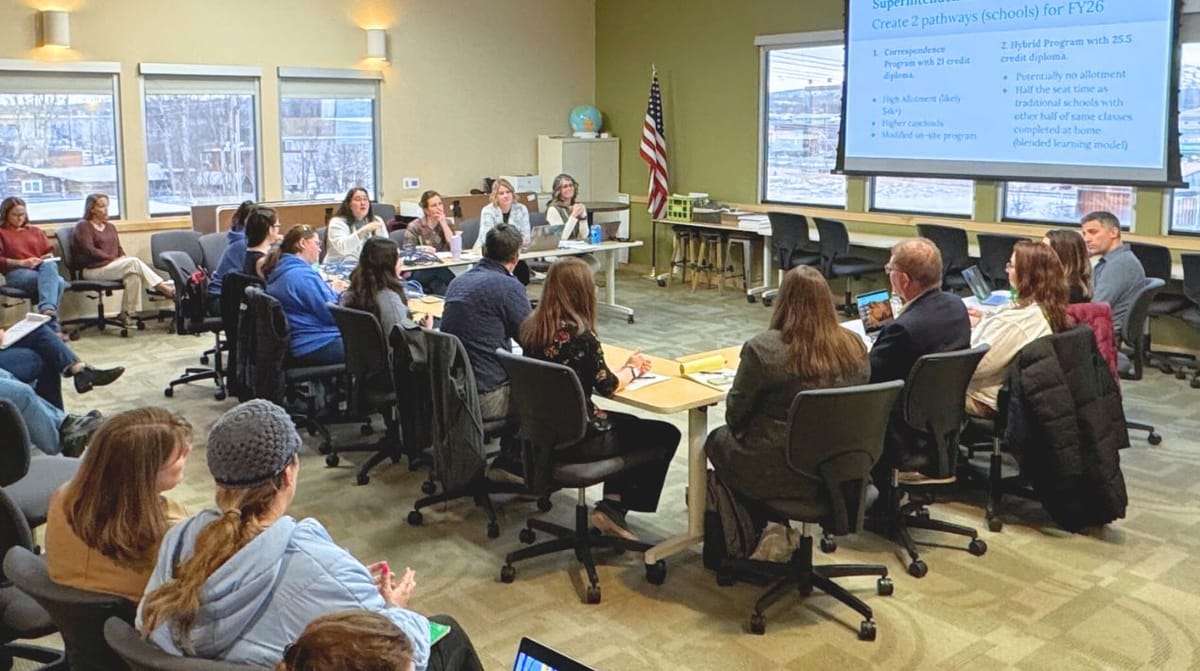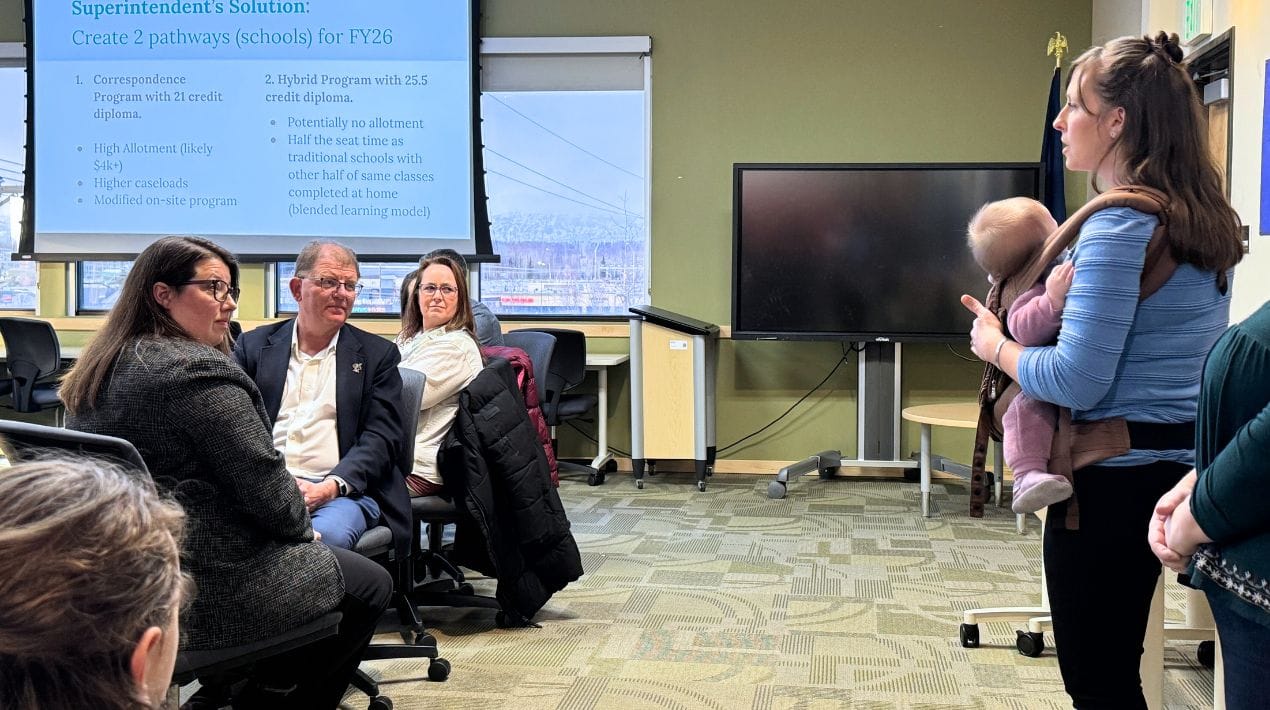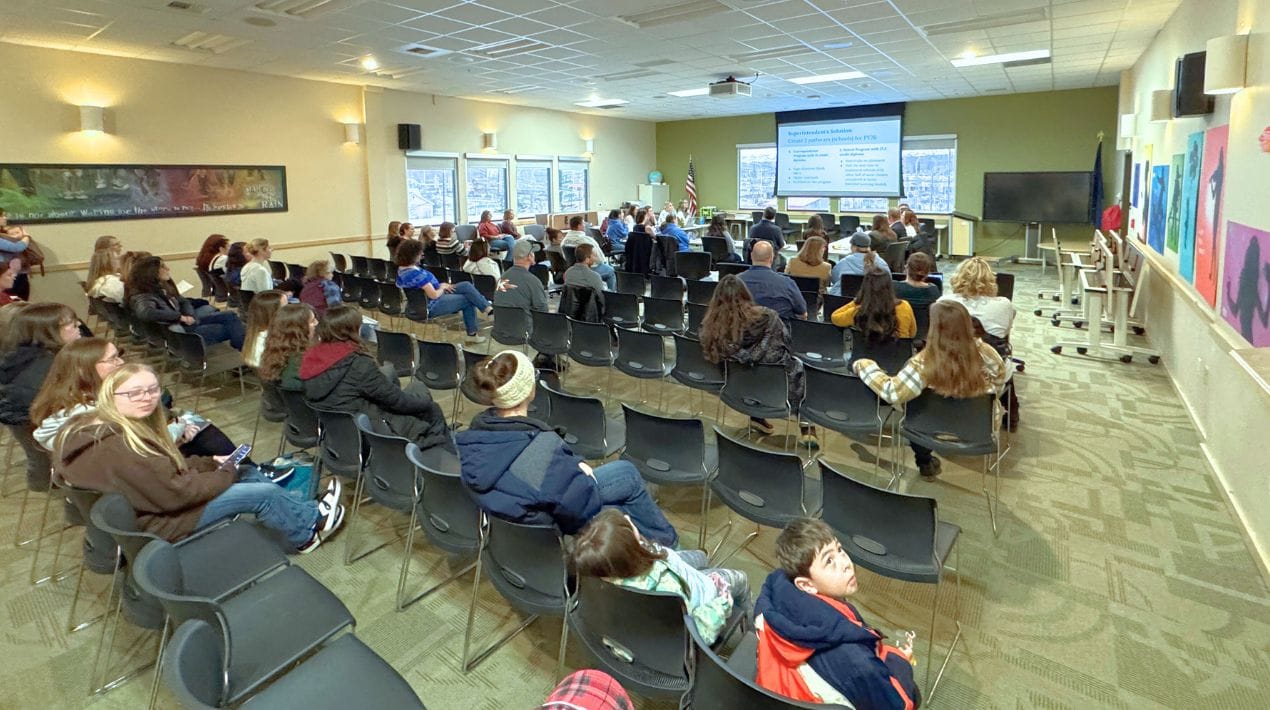Parents, staff push back on Mat-Central overhaul as district readies proposal
The changes include a shift in graduation requirements, higher homeschool allotment payments and class fee increases.

What you need to know:
- Mat-Su School District Superintendent Randy Trani and top district officials met with parents, teachers and students at Mat-Su Central this week to explain proposed program changes that could dramatically alter the school’s structure and costs to families.
- The district faces a $22 million deficit and aims to increase local state education funding by changing how per-student payments are calculated for Mat-Su Central. The restructuring could generate about $3.3 million in additional funding in the first year. The proposal would administratively split Mat-Su Central into two schools, increase district correspondence school allotments, raise class fees and offer lower graduation requirements.
- Parents and advisory members worry the changes will affect the school's community-focused, family-oriented atmosphere. The proposal will be considered at a Feb. 5 school board meeting.
WASILLA — Matanuska-Susitna Borough School District officials sought to allay parents' and teachers' fears about major proposed changes to Mat-Su Central school's operations and funding during a meeting this week, even as details about how those updates will fully affect families remained unclear.
Top district officials, including Superintendent Randy Trani, met with several dozen staff, families and students at Mat-Su Central's Wasilla campus Tuesday afternoon for a nearly two-hour emergency meeting of the school's Academic Advisory Council.
The meeting followed about a dozen days of rumors and uncertainty within the school about how the changes would affect enrolled families and existing staff, some of whom feared for their jobs as a result of the announcement, they told Trani during the meeting.
A program restructuring proposed by Trani at a school board meeting this month would administratively split Mat-Su Central into two schools, reclassifying its in-person classes as a hybrid brick-and-mortar school with new staffing and administrative requirements under state rules. The plan would keep the day-to-day operations of the correspondence program largely unchanged while introducing a new payment structure for enrolled families.
School staff and families said they were not notified of the changes before the announcement. The proposal must be approved by both the school board and state education officials. The school board will consider the plan at its Feb. 5 meeting.
The proposal is key to a district effort to boost incoming education funding by updating how the state calculates per-pupil payments to Mat-Su Central while also attracting more homeschooled students to the program, district officials said.
Mat-Su Sentinel thanks its sponsors. Become one.
The district faces an estimated $22 million deficit for next year and will propose budget cuts, officials said at the school board meeting. If approved, the Mat-Su Central program change could generate about $3.3 million in additional funding within the first year, they said. Officials hope to have the changes in place by August.
Mat-Su Central, the district's largest school with about 2,800 students, operates as a homeschool correspondence program with some face-to-face classes taught by district teachers or vendors. About 500 students enrolled in one or more of those classes this school year, according to district officials. A new 45,000-square-foot, $24 million Mat-Su Central school building, funded by the borough, will be completed this spring and will include nine classrooms.
Unlike the district's brick-and-mortar schools, some of which receive $12,000 per student, Mat-Su Central is funded by the state as if it did not offer in-person classes, officials said. Instead, it receives the lower correspondence student rate of about $7,000 per student, about $3,000 of which is passed on to families as the state's home education allotment.
If approved, the Mat-Su Central proposal would change that calculation, officials said. The restructuring would allow correspondence students to enroll in hybrid program classes on an as-needed basis, much as they do now, while the district would be reimbursed at the higher in-person rate. Students from other district schools could also take those classes, which could be offered at nontraditional times such as nights and weekends, officials said.
The hybrid program would also introduce a high school diploma option with requirements set below the district's current 25.5-credit standard, a change that officials said would attract students who do not want the full district diploma and are currently enrolled in other programs elsewhere in the state.
“We’re facing a $22 million shortfall -- things will need to be cut,” Trani said at the Tuesday meeting. “This is a way not to cut things.”
An estimated 3,000 Mat-Su students are enrolled in correspondence programs outside the district, according to state education data.

The updates would also likely allow the district to pass along higher state education allotment payments to enrolled correspondence school families - about $4,000 instead of the current $3,000. At the same time, class fees would likely increase significantly to better reflect the cost of providing them, officials said.
Families currently pay $50 for most classes offered at Mat-Su Central and pay nothing to enroll in secondary classes at neighborhood schools, which are available on a case-by-case basis. Under the new structure, families will likely pay hundreds of dollars per class, and neighborhood school enrollment would no longer be free, officials said.
The district has not yet determined the final proposed allotment amount, the new class fees, or whether both programs will be overseen by Mat-Su Central's current administrators, Trani told parents at the meeting. Fees will likely be set on a sliding scale based on grade level, subject and other factors, he said in an interview. Administrator decisions are in progress, he said.
Advisory committee members, administrators, teachers and parents at Tuesday's meeting said that while they understand the need to raise class fees, they are concerned that the overall changes will fundamentally alter what they value about the school, including its current administrative team.
“I will not just leave Mat-Su Central; I will leave this school district if you do not retain them,” parent Heather Lockwood said of Mat-Su Central Principal Stacey McIntosh and Assistant Principal Nathan Chud. “And if you do not put them in full charge of this program, you will find other students that don’t attend the on-site classes will leave.”
Advisory committee members and school staff also said they resent Trani's initial announcement and presentation of the program change this month because of how he discussed the school's performance and his comments about the committee.
Mat-Su Central has the lowest graduation rate in the district at about 73%, in part because some students drop out to enroll in other correspondence schools with lower graduation requirements, according to district data. While Trani noted the dropout cause during his board presentation, parents and staff said he did not sufficiently emphasize the challenges it poses for the school.
During the same board meeting, Trani also described the nine-member advisory committee as a group that is no longer needed.

Established by school board policy, the committee includes parents, staff and district representatives and is charged with making recommendations on school policy and budget. It was created to allow the school to operate as a district-run program with some of the freedoms of a charter school, Trani said.
“I call them the blue extension cord -- the extension cord that used to run something very important, but now just this blue extension cord would keep walking across the top of it. We wonder why it’s there,” he told the school board.
Parents and advisory members objected to that characterization.
Sign up for Mat-Su Sentinel
Get stories like this one straight to your inbox.
No spam, we promise. Unsubscribe anytime.
“This group of people here … They were publicly referred to as the blue extension cord you keep stepping over,” said Andrew Lockwood, a parent who also teaches classes at the school and at Mat-Su College. “But that’s not how we see them. We listen. We chose them, and we listen to their advice.”
Siyen Emmert, an advisory committee member who also served on a group that guided plans for the school's new facility and who has been involved with the school for more than a decade, said she worries the new program will hurt the school's family-oriented atmosphere.
“I’m not sure that that’s totally recognized by the district, that this is a very community-based, family-based program,” she said in an interview after the meeting. “We really focused on how to make this a family-oriented space. So it was not designed for what he’s talking about as a hybrid model. It wasn’t designed for kids to come for four classes at a certain time of day.”
-- Contact Amy Bushatz at contact@matsusentinel.com




